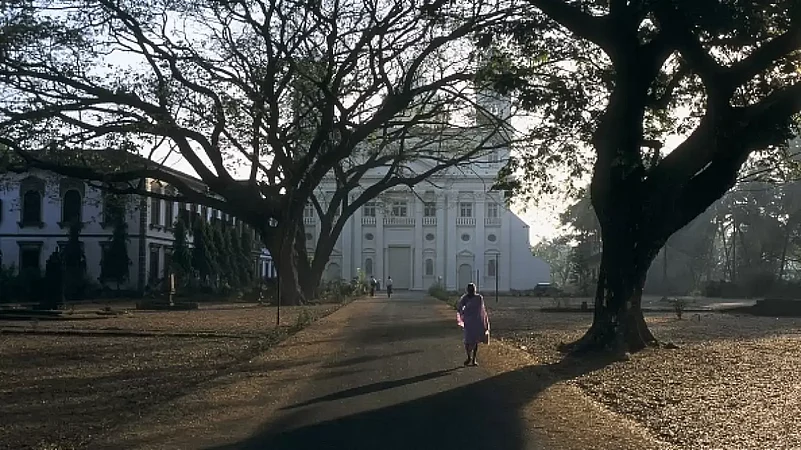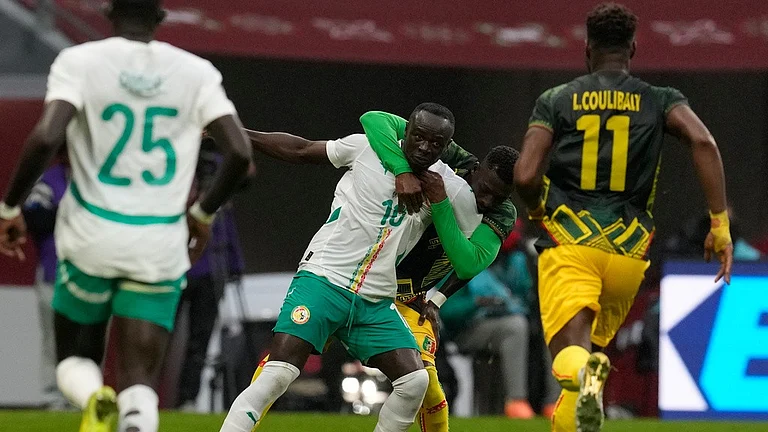Monsoon by Vimala Devi
Introduction by Jason Keith Fernandes
Translated by Paul Melo e Castro
Published by Seagull Books, 2019
MRP: Rs 499.00

I have always believed that in this era of incredulity of meta-narratives, the strongest perspectives and paradigms that stand out are those of beings who have been relegated to margins. Among them, the construction of the category of 'woman' is one of the most important ones. But, the 'making' and 'unmaking' of woman itself goes through a complex intersectional process with varied essentialist frames being imposed on her, which Simone de Beauvoir has highlighted in her writings. 'Projected Essentialism' via a phallocentric order is one of the ways that go into making a woman.
A brief discussion of the above background is essential when I consider the work of Vimala Devi titled 'Monsoon.' This is important as the work has to be looked into in the specific timeframe when it was written. Also, the narratives of the author assume importance in the societal moralities in which 'she' lives as it has a huge impact on her writings. Starting with her name, Vimala Devi, is a portrayal of her adherence to nationalist rhetoric, as her baptismal name is Teresa da Piedadebde Baptista Almeida. The work was originally written in Portuguese in 1963 and was titled Moncao. Now, what appears in my hands is an English translation by Paul Melo e Castro. This brilliant translation is accompanied by a superb yet critical analysis of the stories by Jason Keith Fernandes and supplemented with a rich glossary, which is a significant aid to understanding the multiple subjectivities within the text.
I took up this book accidentally after going through a list of 'Women in Translation’ series suggested by a friend. This is how I encountered this gem. I have to sincerely admit that the reading was tough, not akin to pleasure reading for the sake of reading. Being a Maharashtrian myself, which has cultural ties with Goa in the realms of culture, language, region, religion and, most importantly, the caste-class praxis of Bombay Modernity. These elements played an important role in the emergence of strong anti-caste movements in Maharashtra. The reading was an educative experience and a stark realisation of the post-structural framework while thinking about intersectionalities and questions of women within. Though the book looks slim, it is a treasure of ideas, 'her'stories, the complexities of thoughts, actions and the slow disintegration of the quasi-feudal society.
To throw light on what I mean, let's refer to the first short story titled Nattak. The story portrays fissures within the traditional Goan society where there is a built-up tension pervading in the domains of language, region, caste, religion and sexuality. I had to refer to Anjali Arondekar to make sense of how sexuality could be understood in Goa when there are varied elements of migrations, stigmatisation, and class-caste bias in the inter and intra domains of religion. With all these forces acting on the agency-lacking subject of woman, how to make sense of the society in which they inhabit?
In another story, House Husband, with the flow, what struck me was the making of Vimala Devi herself. The mockery of Catholic customs by portraying the actions of Catholic women as caricatures points to the structural tensions pervading the society of which way to go, Catholic or Indigenous? The story shows the obsession with catholic etiquettes as farce, creating images that paint Catholic customs as devilish, which subordinates natural human tendencies. Power dynamics is at play, along with their dialectics at display in their ability to influence the writer's opinion. Considering this story in the light of the Goa Liberation Movement, with de-nationalism as the fulcrum and formation of the Tocquevillian Public sphere as an upper caste, elite bhadralok, North Indian based, it shows how the contemporary Hindu, Hindi, Hindutva politics made inroads in today's Goa. The seeds were planted in the pre-independence and early-independence period of Goa itself.
The above line of thought continues in the character of 'Dhruva', who appears in the three stories. She is a classic representation of an essentialist Indian, Sanskari woman, which is desired and expected by Manusmriti, Matsya Purana and Medhatithi discourses. Her husband, who initially also aligns with these Sanatana traditions, is later swayed by enlightenment and rational logic when he goes to study medicine in Portugal. In fact, the roots of scientific temper penetrate deep in his mind, which creates tension between the then prevalent Goan feudal order and his liberal, rational humanistic outloook. It instigates him to question the majoritarian patriarchal discourses and see them from the lens of logic. The characters and the events projected in three stories – Dhruva, Fidelity and Returning – are so powerful that they stay with you after finishing the story. The shades of characters of Dhruva and Chandracanta are interesting, as well as disturbing, but they are changing as well as static too.
The questions of the Annihilation of Caste and what way liberation is still a mirage even in Goan society. The Ambedkarian pragmatic solutions are not followed on the pretext of radicalism, but the point missed is that his methodology shall create a pathway for a genderless society. This is the most feared and, thus consequently, is abhorred by the heteronormative and status-quoits order who don't want to disturb the non-pragmatic, dogmatic, yet continued distribution of social and cultural capital. Movements like Bhakti and philosophical approaches like Maitree have been proposed as the new way, albeit a protracted revolutionary way, to an egalitarian order. However, the feudal setup deters it from penetrating the women's consciousness. This is prominently achieved in guarding the sexuality and denial of choice to women, making them a subject of gendered subjugation. These cathartic questions are asked and invoked in the story titled Padmini.
In all, there are sixteen stories and important permeating themes in these stories are the dialectics of the declining Mundacar-Bhatcar system, a quasi-feudal setup comparable to the Jajmani system of Northern India and the Balutedar system of Maharashtra. The time span of these stories shows that there is a distinct hyphenated cosmopolitanism forged by Portuguese-British modernity. Yet the force of Indian nationalism stands as a counter-current to that idea. Within these dialectical encounters, there emerges a fetishism for denationalisation by leaders like T. B. Cunha, who want to model Goa on the lines of Bhartiya culture and try to forge organic connectivity with the Majoritarian yet Brahmanic conception of the Indian National Movement. Thus, making a public sphere modelled on the civic virtues based on Tea and biscuits polite elitism, as stated by Partha Chatterjee. To make this work, a recourse to Orientalism was also made. Hence, what is obtained is a Hindu Public, a syncretic mixture of Hindu nationalism and neo-liberalism based on the foundation of gendered as well as religious minority crushing. (curiously, there is no Muslim character in any of the stories)
A classic depiction of Caste is what appealed to me in these stories. Caste operates differently in these stories. I would beg to differ from Jason Keith Fernandes, who states that it is devoid of the notions of purity and pollution in Goa. But, my reading and interpretation says that it is already being played in the background and what is foregrounded as Caste(s) is Nobility and Ancestry. In fact, there is social osmosis wherein Caste(s) pervades Christianity, which is so evident in the writings of Bama and Sujatha Gidla. However, the fact can't be negated that Catholicism acted as balm across gender, caste and class praxis shown in the other works of Charu Gupta, sociological analysis of conversions in Ahmednagar (now with a new sanitised name imposed to suit the contemporary rhetoric - Ahilyanagar). This claim to the idea of 'being Brahmin' is evident in claims of the Catholic elite, which is naturalised for Hindu Brahmin. The writing, though written in the geographical proximity of Portugal, follows the same Indianised discourse of bahujans lacking agency and always being oppressed via class-caste praxis. This is disappointing but also reflects a general Gandhian harijanic tendency, Bahujans lacking agency and their conditions invoking sympathy. The stories show some deep connections of language, religion, class and caste in the society of Goa, with a million mutinies on the verge of explosion. In these circumstances comes the annexation of Goa by India (1961), which overshadowed these fissiparous tendencies under the broader category of Political Independence.
The text is a timely translation to understand contemporary Goan society, which is today modelled as a prime example of the Uniform Civil Code, which conceptually is branded as the only panache for all ills of society in India. In fact, understanding 'Vimala Devi', too, points to the backward linkages for understanding the Political sphere of Goa. The translation by Paul Melo e Castro gives a distinct Goan flavour to the text, taking the reader to the then times and generating images that illuminate and educate the reader to foreground a neglected and much taken-for-granted territorial part of India. The text dents the idea of Goa as a tourist and materialistic hub but creates an image of complex cultural geography with many discourses pervading the public and private spheres. Vimala Devi as an author for me, though imbibed in the discourse of parochial Hindu nationalism, is a great revelation for me, and I hope to read her other works, which educate the 5G generation like me to understand the power(s) of discourses emanating from multiple agencies and viewed from the narrative of women rather than phallocentric 'his'tories.

























